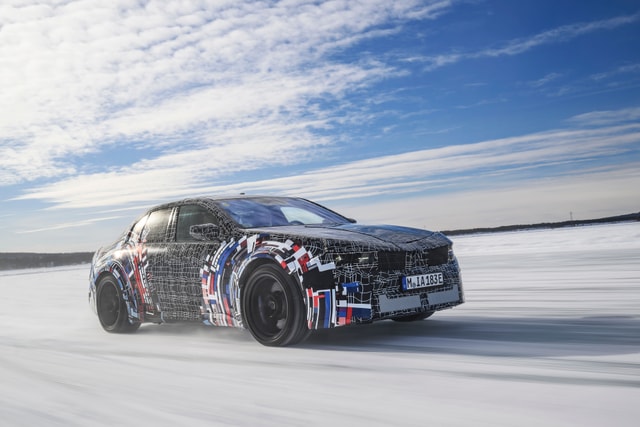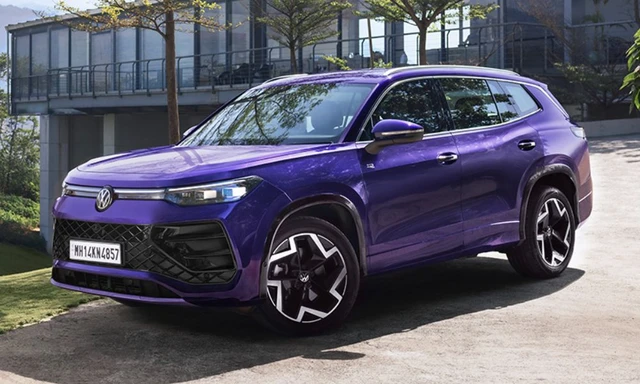Toyota Hilux Hydrogen Fuel Cell Electric Vehicle Prototype Unveiled With Up To 590 KM Range

- Hydrogen-powered Hilux prototype derives fuel-cell technology from the Mirai FCEV.
- Three high-pressure tanks installed to store hydrogen gas, enabling a range of close to 590 kilometres.
- Prototype developed in a little over a year using funds gained from the British government through the Advanced Propulsion Centre.
A hydrogen-powered Toyota Hilux has made its global debut in the United Kingdom as part of the Japanese carmaker’s multi-pronged powertrain strategy for the future. Showcased in prototype form, the Hilux fuel cell electric vehicle (FCEV) derives powertrain technology from the Mirai, a hydrogen-fuelled Toyota sedan that is already in production. The Hilux FCEV rolled out of Toyota’s Burnaston plant in Derby, where it was developed as a joint project funded by the British government through the Advanced Propulsion Centre. This is the first of a total of 10 such prototypes that will be built and tested to study the performance and feasibility of a production model.
Also Read: Toyota To Add 48-Volt Technology To Certain Hilux Models
Fuel cell stack is positioned under the Hilux's bonnet.
In place of the venerable 2.8-litre turbo-diesel engine under the bonnet is the fuel cell stack borrowed from the Mirai sedan. Three high-pressure storage tanks have been incorporated into the centre of the Hilux’s frame, which store hydrogen gas and enable a range of close to 590 kilometres. The battery, which stores electricity produced by the fuel cell stack, is situated in the load bay at the rear in a bid to avoid a reduction in interior space. The load bay itself is covered by a steel lid. Just like the Mirai, Toyota says the Hilux will only emit water vapour on the move.
Also Read: Toyota Hilux Review
Three high-pressure hydrogen storage tanks are placed in the centre of the Hilux's frame.
The project initially began as a feasibility study early in 2022, and construction of the prototype only began at the start of June this year. Engineering firm Ricardo supported the technical integration of the fuel cell components into the Hilux’s chassis, with D2H Advanced Technologies conducting computational fluid dynamics (CFD) analysis and Thatcham Research in charge of validating repairability and creating an FCEV training package for the repair market.
Also Read: Toyota Reveals IMV 0, Hilux Revo BEV Concepts To Commemorate 60 Years In Thailand
Toyota will build 10 prototypes of the hydrogen-powered Hilux for testing.
This is not the first zero carbon emissions version of the Hilux showcased in 2023. In March, Toyota had taken the wraps off of the battery electric Hilux concept, hinting at how the workhorse could evolve in the time to come. Closer to home, Toyota joined hands with the International Center for Automotive Technology (ICAT) to study the feasibility of hydrogen vehicles in India, using a Mirai sedan for on-road testing.
Also Read: Toyota Innova Hycross Flex-Fuel Hybrid MPV Makes World Premiere In India
Toyota also recently lifted the veil on the world’s first ethanol-powered BS6 Phase-II vehicle, the Innova Hycross Flex-Fuel hybrid.
Latest News
 Jaiveer Mehra | Jan 15, 2026Kia Carens Clavis Gets New Sunroof-Equipped HTE(EX) Trim; Prices Start From Rs 12.55 LakhNew lower mid-spec trim is positioned between the HTE(O) and HTK variants and gets some additional features.1 min read
Jaiveer Mehra | Jan 15, 2026Kia Carens Clavis Gets New Sunroof-Equipped HTE(EX) Trim; Prices Start From Rs 12.55 LakhNew lower mid-spec trim is positioned between the HTE(O) and HTK variants and gets some additional features.1 min read Seshan Vijayraghvan | Jan 15, 2026All Electric BMW M3 Details Out; Will Offer Simulated Gear Shifts, Synthetic SoundsThe first EV from the high-performance division of BMW will get individual electric motors of all 4 wheels1 min read
Seshan Vijayraghvan | Jan 15, 2026All Electric BMW M3 Details Out; Will Offer Simulated Gear Shifts, Synthetic SoundsThe first EV from the high-performance division of BMW will get individual electric motors of all 4 wheels1 min read Jaiveer Mehra | Jan 15, 2026Volvo EX60 SUV Global Debut On Jan 21; Will Offer 810 km RangeNew GLC EV rival will be the first Volvo to use the next-gen SPA3 platform and support 400 kW fast charging.1 min read
Jaiveer Mehra | Jan 15, 2026Volvo EX60 SUV Global Debut On Jan 21; Will Offer 810 km RangeNew GLC EV rival will be the first Volvo to use the next-gen SPA3 platform and support 400 kW fast charging.1 min read Jaiveer Mehra | Jan 15, 2026India-Spec Volkswagen Tayron RevealedThree-row SUV will be offered in the R-Line trim with features like 19-inch wheels, a 15-inch touchscreen, front seats with ventilation & massage function and more.1 min read
Jaiveer Mehra | Jan 15, 2026India-Spec Volkswagen Tayron RevealedThree-row SUV will be offered in the R-Line trim with features like 19-inch wheels, a 15-inch touchscreen, front seats with ventilation & massage function and more.1 min read car&bike Team | Jan 15, 2026Mercedes-Benz EQS SUV Gets A Celebration Edition For 2026, Prices start at Rs. 1.34 CroreThe new celebration edition will be available with both the EQS 450 and the EQS 580 versions of the SUV.1 min read
car&bike Team | Jan 15, 2026Mercedes-Benz EQS SUV Gets A Celebration Edition For 2026, Prices start at Rs. 1.34 CroreThe new celebration edition will be available with both the EQS 450 and the EQS 580 versions of the SUV.1 min read Jaiveer Mehra | Jan 15, 2026Auto Sales: Mercedes-Benz Sales Decline 3 Per Cent; 19,007 Units Sold In CY2025The German carmaker reported year-on-year growth in sales for its Top-End Vehicles (TEVs), EV range, and AMG models, although sales in entry-level segments were down 20 per cent.3 mins read
Jaiveer Mehra | Jan 15, 2026Auto Sales: Mercedes-Benz Sales Decline 3 Per Cent; 19,007 Units Sold In CY2025The German carmaker reported year-on-year growth in sales for its Top-End Vehicles (TEVs), EV range, and AMG models, although sales in entry-level segments were down 20 per cent.3 mins read
 Bilal Firfiray | Jan 9, 2026Toyota Urban Cruiser Hyryder: 10,000 km Long-Term ReviewAfter spending over three months and 10,000 km with the Toyota Urban Cruiser Hyryder Hybrid, we were impressed by its real-world mileage, seamless hybrid, practical comfort, and Toyota reliability. Is it the best C-SUV then?5 mins read
Bilal Firfiray | Jan 9, 2026Toyota Urban Cruiser Hyryder: 10,000 km Long-Term ReviewAfter spending over three months and 10,000 km with the Toyota Urban Cruiser Hyryder Hybrid, we were impressed by its real-world mileage, seamless hybrid, practical comfort, and Toyota reliability. Is it the best C-SUV then?5 mins read Seshan Vijayraghvan | Jan 8, 20262026 Mahindra XUV 7XO Review: Big On Tech, Bigger On ComfortThe new Mahindra XUV 7XO is flashier, feature packed, and comes with more advanced tech. But are the changes just incremental or actually substantial?1 min read
Seshan Vijayraghvan | Jan 8, 20262026 Mahindra XUV 7XO Review: Big On Tech, Bigger On ComfortThe new Mahindra XUV 7XO is flashier, feature packed, and comes with more advanced tech. But are the changes just incremental or actually substantial?1 min read Preetam Bora | Jan 10, 2026Simple One Gen 2 First Ride Review: 265 km Claimed Range!The Gen 2 model of Simple Energy’s first electric scooter gets a fair few updates, including new features, tech, more range and lighter weight. We spent a couple of hours with the Simple One Gen 2 to find out if it manages to impress.6 mins read
Preetam Bora | Jan 10, 2026Simple One Gen 2 First Ride Review: 265 km Claimed Range!The Gen 2 model of Simple Energy’s first electric scooter gets a fair few updates, including new features, tech, more range and lighter weight. We spent a couple of hours with the Simple One Gen 2 to find out if it manages to impress.6 mins read Amaan Ahmed | Jan 3, 2026VLF Mobster 135 300 KM Review: Fun But FlawedA 125 cc scooter with Italian design and Chinese genes is a rare combination, and while some may be tempted to dismiss it because of its origins, the VLF Mobster shows 125s can also be exciting – but not without compromises.11 mins read
Amaan Ahmed | Jan 3, 2026VLF Mobster 135 300 KM Review: Fun But FlawedA 125 cc scooter with Italian design and Chinese genes is a rare combination, and while some may be tempted to dismiss it because of its origins, the VLF Mobster shows 125s can also be exciting – but not without compromises.11 mins read Preetam Bora | Dec 30, 2025TVS Orbiter Review: Real-World Performance and Range TestedThe TVS Orbiter is a promising electric scooter promising decent range, practicality and pricing. But is there any reason to avoid it? We spent a few days getting to know it better.9 mins read
Preetam Bora | Dec 30, 2025TVS Orbiter Review: Real-World Performance and Range TestedThe TVS Orbiter is a promising electric scooter promising decent range, practicality and pricing. But is there any reason to avoid it? We spent a few days getting to know it better.9 mins read

































































































































